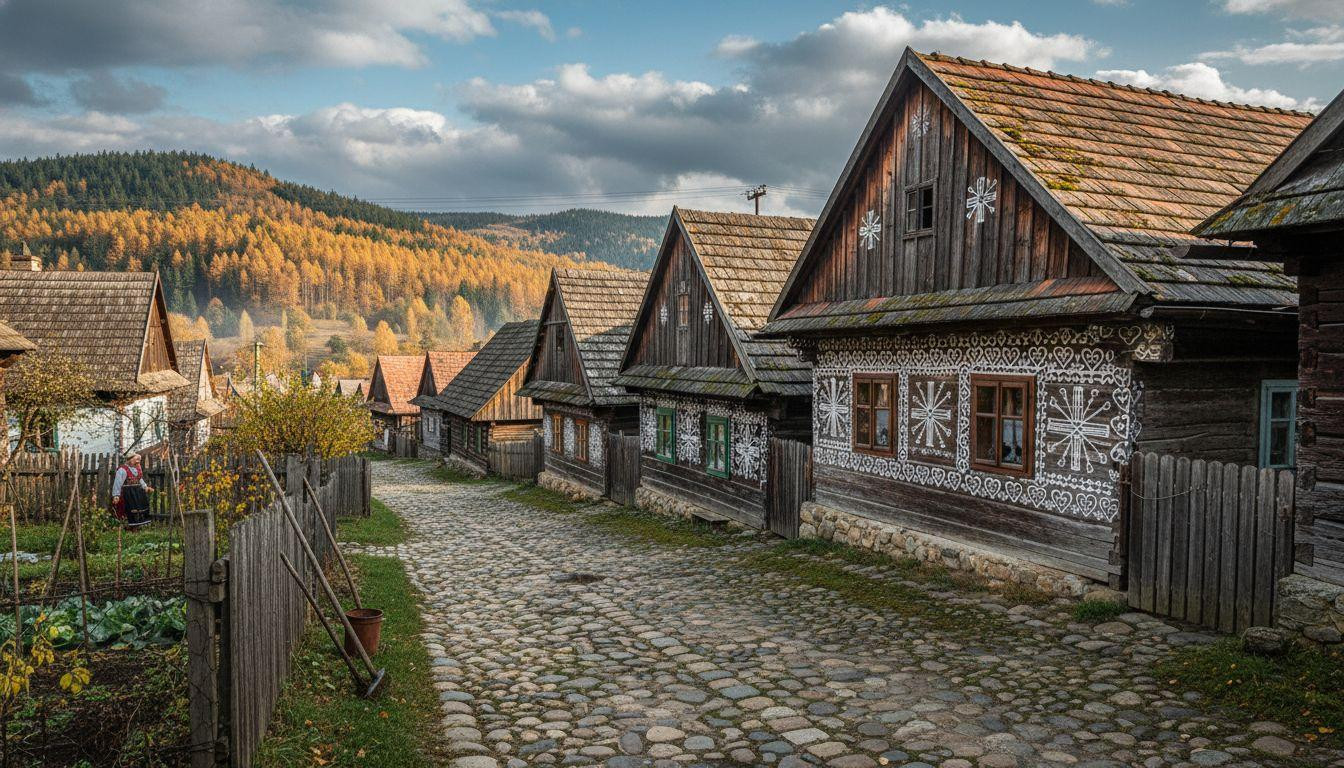Morning light touches Čičmany’s timber houses at 7:45 AM, transforming white geometric patterns into brilliant contrast against dark wood. Steam rises from 200 residents’ breakfast windows while forested mountains glow green beyond the village edge. This isn’t another Alpine tourist village charging $165+ daily. This is Slovakia’s forgotten masterpiece: 136 houses decorated in folk patterns unchanged for 200+ years, designated the world’s first folk architecture reserve in 1977, yet costing travelers just $44-66 per day.
Where dark wood meets white geometry 90 minutes from Bratislava
Čičmany sits in northern Slovakia’s Žilina region, 2 hours northeast of Bratislava by car. The village emerges from forested hill terrain at 2,149 feet elevation. Narrow mountain roads wind through smaller Slovak villages before revealing 136 black timber houses covered in white lime patterns.
Access begins through Bratislava’s M.R. Štefánik Airport, 121 miles south. Car rental provides the most practical option, as public transportation remains limited. The drive winds through increasingly scenic terrain, transitioning from Slovakia’s central plains into wooded approaches.
The village requires no vehicle once you arrive. Čičmany’s narrow streets and compact layout are designed entirely for pedestrian exploration. Most of the village is accessible within a 30-minute walk.
The village that wears its folk costume on every wall
The revelation of what makes Čičmany unique: houses decorated identically to traditional embroidery. This village of 1,004 where half-timbered facades turn amber when sunset backlights western walls shares similar timber-frame traditions, but Čičmany’s geometric language is utterly distinct.
200 years of lime paint preserving 750 years of history
Women began using white lime as practical wood preservative around 1825. The timber frames, vulnerable to weather damage and moisture, required protection. The bright lime pigment created striking visual contrast against dark wood.
Over time, functional preservation evolved into elaborate artistic tradition. The Great Fire of 1921 destroyed many wooden structures. Crucially, reconstruction funds came with conditions: families received support only if they employed traditional building techniques.
Geometric patterns that live on wood and fabric
Design vocabulary includes abstract shapes, stylized animals, arrows, clovers, crosses, hearts, stars, spirals, and pinwheels. These motifs appear in carefully composed arrangements across facades. The patterns feature lacy, geometric elements creating almost textile-like quality on wood.
Same patterns appear on house exteriors, folk costumes, and handmade textiles. This integration across mediums suggests residents view decorative patterns as coherent language expressing community identity.
Walking between houses that breathe folk art
The tangible experience of being in Čičmany transforms visitors through comprehensive visual consistency. This village of 200 people glows amber for 45 minutes every sunset in Catalan France shares identical population size, but Čičmany’s folk art creates entirely different atmosphere.
Two house museums and 134 living artworks
Radenov dom and Gregorov dom house interior folk collections. Admission costs $2.20-3.30. Walking routes follow compact 30-minute village circuit along narrow cobblestone streets.
Sensory atmosphere includes rural quiet, roosters crowing, residents tending gardens. Light quality shifts throughout day: morning shadows emphasize patterns, afternoon sun flattens facades to brilliant white geometry.
Autumn colors and mountain forests beyond pattern-covered walls
Late September through October offers optimal timing. Temperatures reach 64-68°F with dramatic autumn foliage. Minimal crowds allow authentic encounters with residents pursuing daily life independent of tourism.
Traditional Slovak cuisine costs $5.50-11 per main course. Local specialty bryndzové halušky (potato dumplings with sheep cheese) represents the most affordable option. Some residents continue producing traditional textiles incorporating house patterns.
What Hallstatt costs $200 daily, Čičmany delivers for $55
Direct comparison reveals stark differences. Hallstatt receives over 1 million annual visitors with extensive commercialization. Čičmany attracts primarily travelers specifically seeking it rather than incidental tourists. This fortress city where honey-colored stone turns amber when the sun sinks low shares UNESCO-level heritage preservation themes.
White geometric timber decoration remains unique to Čičmany, distinguishing it visually from other European heritage sites. The village maintains 200 residents pursuing livelihoods that anchor genuine community life. This village where donkeys haul Amazon packages down cobbles unchanged since 1550 demonstrates similar authentic adaptation to modern life while preserving historical practices.
Your questions about Čičmany’s painted village answered
When should I visit and how much does it cost?
Optimal timing: late September-October (64-68°F, autumn colors, minimal crowds). April-May provides secondary option for avoiding peak summer crowds. Budget breakdown: accommodation $42-55/night (guesthouses, family-run), meals $5.50-11/main course, museums $2.20-3.30.
Car rental strongly recommended as public transport remains limited. Total daily cost: $44-66 versus $165+ for comparable Austrian heritage villages.
Why are the houses decorated this way?
White lime originally preserved vulnerable timber from moisture and weather damage 200+ years ago. Functional preservation evolved into elaborate artistic tradition over generations. Same geometric designs appear on folk costumes, handmade textiles, and traditional slippers.
Pattern continuity expresses community identity rather than tourism decoration. Residents maintain patterns through generations, not recreating for visitors.
How does Čičmany compare to other European folk villages?
World’s first folk architecture reserve designation (1977) preceded similar protections elsewhere. White geometric timber patterns found nowhere else in Europe. Minimal tourism infrastructure versus extensively commercialized Alpine villages.
200 residents pursue traditional livelihoods versus heritage villages becoming primarily tourist residential. Daily costs $44-66 versus $165+ for comparable Austrian or German destinations.
Late afternoon sun angles low across Čičmany’s cobblestones, transforming white patterns into three-dimensional geometric shadows. A resident tends her garden beneath house decorations her grandmother maintained before her. The village hasn’t frozen in time but simply continues, patterns fresh on timber, 200 residents preserving what millions never knew existed.
